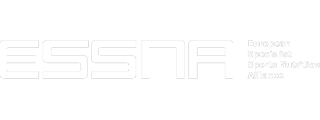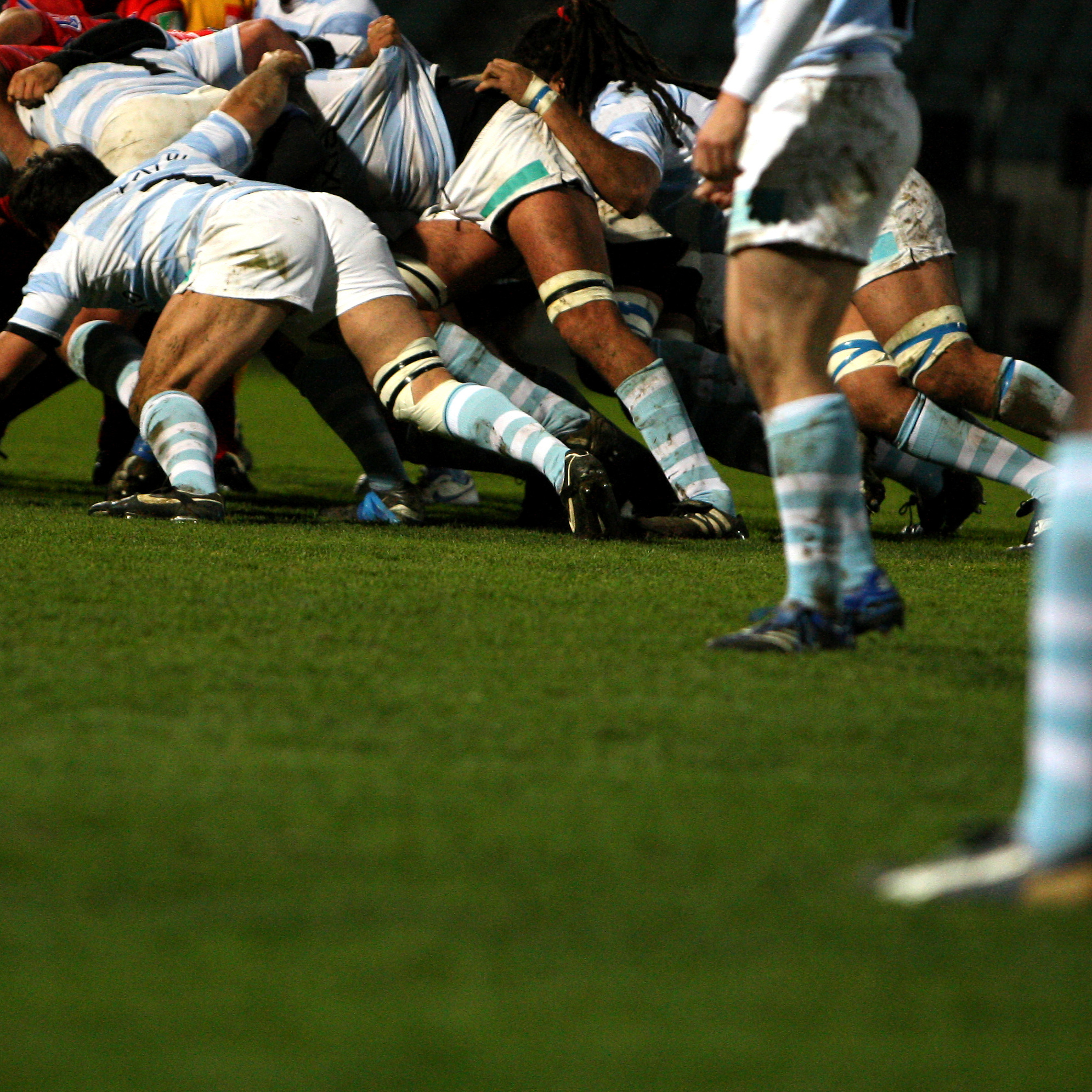No matter which code of rugby you are playing a good nutrition strategy is vital, but how exactly should you feed for maximum growth, repair and game day performance?
In our latest X-Change paper, co-written by Dr James Morehen and Professor Graeme Close, we explore just this; looking at the nutritional requirements for rugby players across multiple areas such as carbohydrate intake, protein consumption and hydration.
Read the full X-Change article here or download the PDF via the button below.
Practical Implications
- Rugby union and rugby league are two different codes of rugby with major differences in the rules of game, however, the players share many common traits and require similar nutritional strategies.
- Both codes of rugby require players to possess a high degree of lean muscle mass to withstand the high-speed physical collisions frequently experienced during game play and practice.
- There is no single ideal physique for rugby players with players demonstrating considerable variations both between and within the various playing positions. This means body composition must be optimised on an individual basis rather than striving to achieve a perceived generic ideal rugby player physique.
- For the professional player, daily carbohydrate intake should be periodised in line with the differing demands of each day (i.e., a light training day versus a rest day versus a game day) to ensure players are fully fuelled for the demands of the game and to maintain an optimal body composition. We have typically seen between 3-6 g.kg-1 carbohydrate per day consumed dependent upon the demands of the day.
- To support gains in muscle mass, recovery and repair from training and game-play, protein should be consumed regularly throughout the day with a minimum of 1.6 g.kg-1 consumed per day consumed as 4 x 0.4 g.kg-1 doses.
- Dietary supplements are often used in rugby to help achieve macronutrient targets and for in-game fuelling. Additionally, there are a range of dietary supplements which are purported to help enhance training and performance (i.e., creatine, beta alanine and caffeine) which are frequently used within elite rugby.
Background
Rugby Union (RU) and Rugby League (RL) are two codes of rugby which are played professionally by thousands of players in both the Northern and Southern hemispheres. Although the purists would argue that the sports are vastly different in rules, history and culture, the two codes share commonalities such as running, carrying and passing the ball, high-intensity tackling and collisions, and wrestling. The rugby codes are characterised by frequent bouts of high-intensity exercise (e.g., striding sprinting, tackling, wrestling and grappling) interspersed with periods of lower-intensity activity including standing, walking, and jogging. In brief, players will cover ~68 m.min-1 during RU (1) to 100 m.min-1 for RL (2) in a match. Movement demands are lower than those reported for Australian football (129 m.min-1) and soccer (104 m.min-1) (3), although the demands of rugby are significantly increased through the high-impact collisions frequently incurred throughout a game. Although game demands are similar between the two codes of rugby, the skills and fitness required during competition is different resulting in few players in the modern era successfully transitioning between codes.
Players in a RL team can be largely divided into forwards and backs, with the forwards traditionally being the larger, heavier athletes and the backs being lighter, agile and faster. These classifications have changed somewhat with the merging demands of the modern game, i.e. forwards being involved in more wide running plays and backs being more involved in physical collisions. Many teams now have 3 major groups, these being the backs (centres, wingers and full backs), adjustables (stand off, scrum half and hooker) and forwards (props, second row and loose forward). The physical demands of RL were recently reported in a meta-analysis of 30 studies (4). Significant differences were observed between positional groups with data demonstrating that, compared with the adjustables and backs, forwards spent the least amount of time (minutes) on the field (− 17.2 ± 5.6 less than adjustables and − 25.6 ± 5.8 min less than backs, respectively.) Additionally, forwards cover less total slow-speed (1348-m) and high-speed distance (139 m) compared to backs (2230-m and 229-m respectively). However, when distance was expressed relative to playing time, the forwards were not different to adjustables and backs in running demands. The adjustables and backs were similar in most variables, except playing time (shorter for adjustables, − 8.5 ± 6.2 min), slow-speed distance (greater for adjustables, + 882 ± 763 m) and total relative distance (greater for adjustables,+ 11.3 ± 5.2 m·min−1). Regarding frequency of efforts and collisions, forwards are involved in most relative repeated high-intensity efforts (RHIE)(0.08 per min) when compared to backs (0.05 per min), and total (12.8) and relative collisions (0.41 collisions per min) compared to backs (12.0 total and 0.32 collision per min). Taken together, data shows that RL forwards are required to frequently gain metres by running the ball into contact and regain possession of the ball through high impact tackles, whereas backs are typically required to distribute the ball as quickly as possible and gain metres by running into open space and evading contacts.
In RU, players are still largely classified as backs (full back, wingers, centres, fly half and scrum half) and forwards (props, hooker, locks, and back row). Research has shown RU players to cover total distances between 4662 and 7227 m during game-play with significant differences between the forward and backs. Backs were shown to cover greater total distances (6545 m) at higher average running speeds (71.1 m.min-1) than forwards (5850 m and 64.6 m.min-1, respectively). Additionally, backs covered most of the total distance walking (46.3%) and covered more relative distance sprinting (35.4%) compared to forwards (46.2% jogging). Professional RU players experience considerably different physical collision demands based on playing position. Front row and back row forwards competing in the Super Rugby competition (5) spent significantly greater amounts of time rucking and mauling (7% and 5%, respectively) compared to inside backs (1%) and outside backs (0.5%). This agrees with recent GPS studies that have reported forwards to be involved in a considerably higher number of heavy physical collisions (6,7).
Anthropometric requirements of the game
Given the physical demands of both codes of rugby, to be a successful player it is essential that players achieve high levels of muscle mass, power and strength to survive the contact activities (8). A typical pre-season period in rugby tends to be 6-12 weeks in duration and it is during this time that players have dedicated time to develop hypertrophy, strength and power (9). Many players during this pre-season phase attempt to improve their body composition (i.e., increased muscle mass, decrease fat mass) to commence the playing season in the best possible physical condition. The relative importance of physical, anthropometric and skill qualities to team selection has been investigated showing those players selected for elite competition are leaner, had faster 10 m and 40 m sprint times, superior vertical jump performance and greater aerobic power than the non-selected players (10). It is therefore important that rugby players possess physical characteristics and a body composition (i.e. high lean mass with low fat mass) that can sustain both the cardiovascular fitness required to play 80 minutes and also cope with the repeated and frequent collisions which results in increases in both exercise and impact induced muscle damage (11,12). Figure 1 depicts the typical anthropometric characteristics of elite RL players based on their positional group (data taken from 14).
Despite the move towards a homogenous profile for all positions within RL, it is important to stress that there remains some variations within positional groups (13–16). For example, whilst the mean total mass of centres was reported to be 91 kg, the range was 79-103 kg whereas, with the prop forwards, whilst the mean total mass of 102 kg, the range was 89 kg – 128 kg. These within position differences are also apparent with body fat with the prop forwards having a mean body fat of 16.3% with a range of 10-23% (14). Taken together, an ideal body composition profile does not exist for RL players, despite many coaches and players striving to achieve one, and therefore players should look to optimise their own profiles specific to their personal physiology rather than striving to achieve some arbitrary ‘one size fits all’ figure.
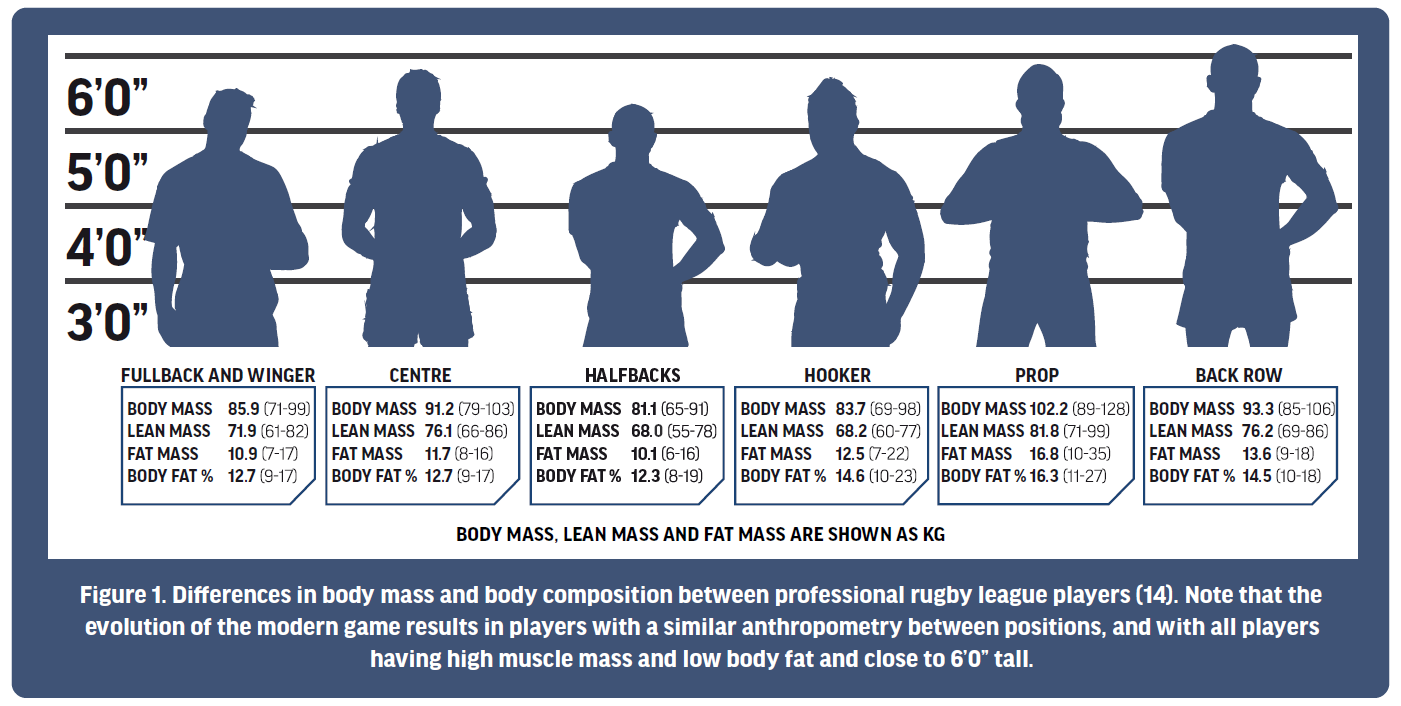
Although positional group differences have been reported in RL, similar studies in RU are not available in the literature. Instead, studies report players as either forwards or backs. The most recent data from professional RU players from the New Zealand Super Rugby Championship (16) shows forwards were significantly taller and heavier than backs, and possessed greater lean mass, fat mass, fat percentage, bone mass and skinfolds. Forwards demonstrated greater strength and absolute power measures than backs but were slower and possessed less aerobic fitness. Fat mass and fat percentage demonstrated very large correlations with speed and aerobic fitness measures within forwards (16). Available data (https://www.englandrugby.com/england/senior-men/squad) from this year’s England RU team, shows players in the prop position to be the heaviest (121 kg) and versus scrum half’s who are the lightest (83 kg). As expected, locks are the tallest (199 cm) and scrum halfs the smallest (176 cm) in stature unpublished DXA data available from one professional RU squad in the Northern Hemisphere show different body composition profiles between playing positions. As expected props are the heaviest with the greater fat mass, whereas the halfbacks are the lightest and with the least fat mass (Figure 2).
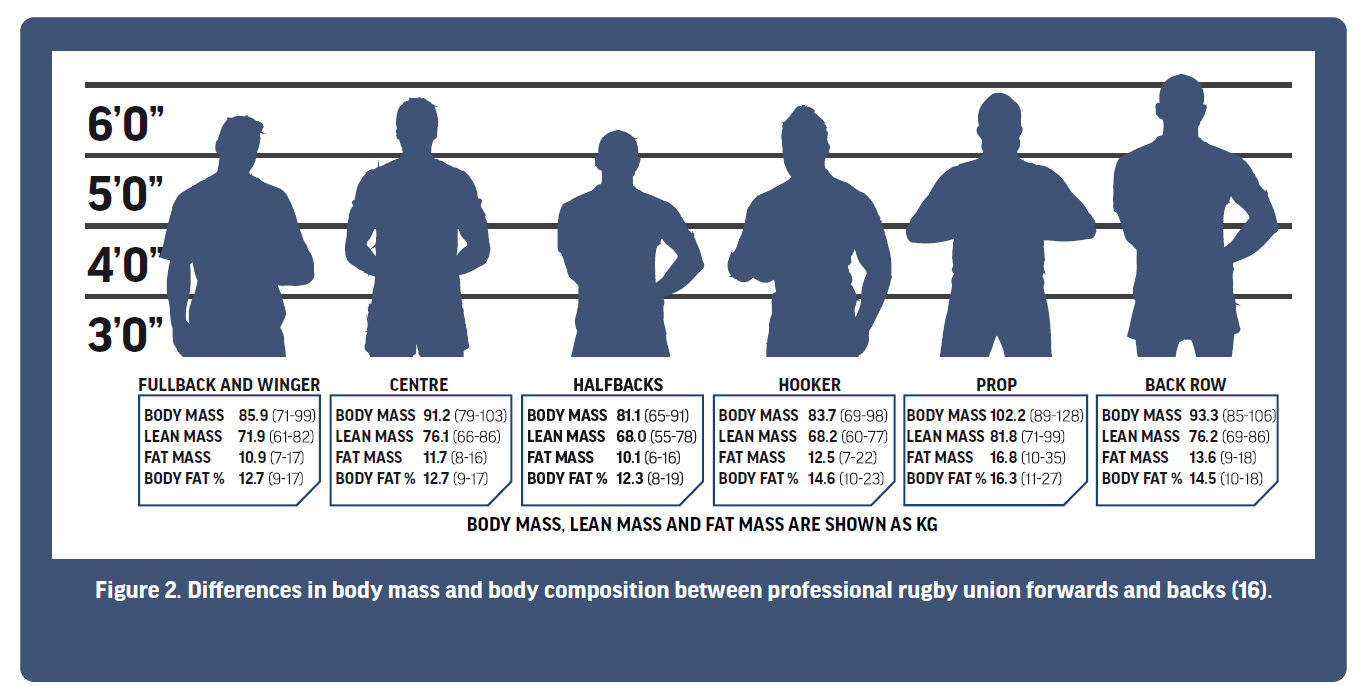
An interesting observation shows how locks posses the greatest lean mass although not being as heavy as props.
Outside of the physical training, an area of real importance for rugby players of both codes is nutrition. Nutrition plays a key role for the professional player and if implemented correctly, a well-planned and periodised nutrition strategy should enhance training adaptation, improve body composition, reduce injury risk, promote recovery and fuel winning performances.
Carbohydrate requirements for rugby players
Given that the body’s storage capacity for carbohydrates (CHO) is limited (~500g), and that muscle glycogen (the body’s main store of CHO) is the main fuel source for moderate to high-intensity exercise, an adequate dietary intake of CHO has traditionally been the focus of the rugby players daily energy requirements. Although low CHO, high fat diets have made the headlines in recent years, a nutritional strategy of this nature is not viable for the professional rugby player. For example, muscle biopsy studies showing the effects of CHO on soccer performance (high-intensity team sport similar to rugby) (17) and more recently rugby performance (18) highlight the importance of CHO for high-intensity performance. Both studies display a clear reduction in muscle glycogen during game-play with rugby players experiencing a 40% reduction in muscle glycogen content before and after competition.
Fuel for the work required
Traditional approaches of prescribing CHO requirements as a percentage of energy intake is poorly correlated to the actual amount of CHO consumed and the fuel requirements of the athlete’s training and competition demands (19). Moreover, describing CHO as a percentage can be problematic, as a player may achieve a high percentage CHO diet, (for example 60% CHO intake) but this may not be enough CHO to meet sporting recommendations defined in grams per kg body mass if the total caloric intake is low. On top of this, it can be somewhat difficult to work out total daily CHO amounts as a percentage when all food labelling is described as absolute grams. Considering this, it is better to discuss CHO requirements in terms of the absolute CHO availability (i.e., amount of grams per kg body mass of the athlete) required to meet the energy demands associated with the training and competition (9)(20).
The day before a rugby game (often termed game day minus 1 [GD-1]), players should be consuming ~6.g.kg-1 CHOs to adequately fuel for performance. On other days of the week, players tend to consume less CHOs; normally in the region of 3-6.g.kg-1 with the absolute amount dictated by the amount of training required on a given day (Figure 3). This approach of manipulating CHO based on the demands of the day has been termed “fuel for the work required”. Table 1 summarises the fuel for the work required with respect to CHO, and includes approximate amounts suggested for different days of a players week in relation to game day.
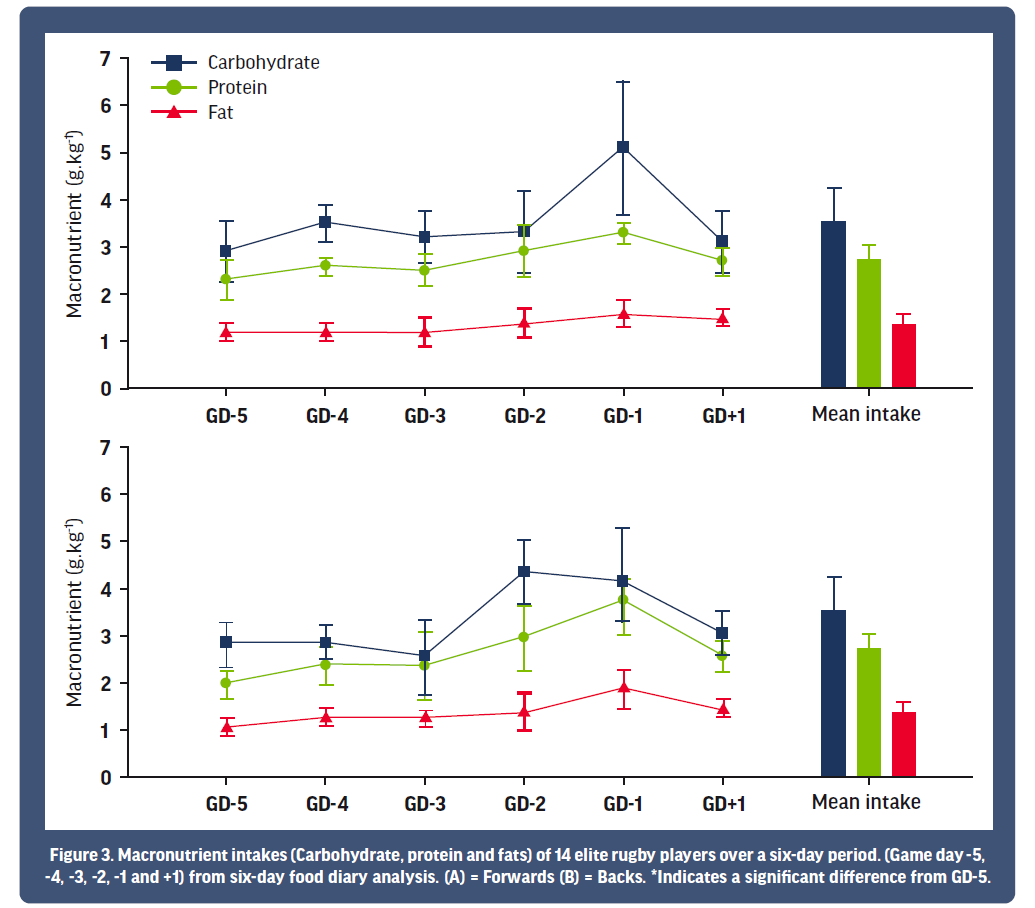
Type of carbohydrate
CHOs can be classified according to their glycaemic index (GI), which is a numerical scale from 0-100 based upon the speed in which the food raises blood glucose (0 being slow and 100 being very high). A rugby player would be advised to consume the majority of the CHO intake from low to medium GI foods due to their numerous metabolic and health benefits. Moreover, there are suggestions that even on game day, low GI foods may be advantageous to prevent rapid spikes followed by a rapid crash in blood glucose, (termed rebound hypoglycaemia). However, because of the capacity of high GI CHO foods to increase plasma glucose levels (and thus promote muscle glucose uptake), high GI foods would be particularly beneficial in the post-exercise period, so as to maximise rates of muscle and liver glycogen re-synthesis and thus promote recovery (21), in addition to being a good option to be consumed during exercise. Figure 4 depicts typical CHO foods consumed by rugby players and their corresponding GI and Figure 5 represents a typical CHO intake on a training day.
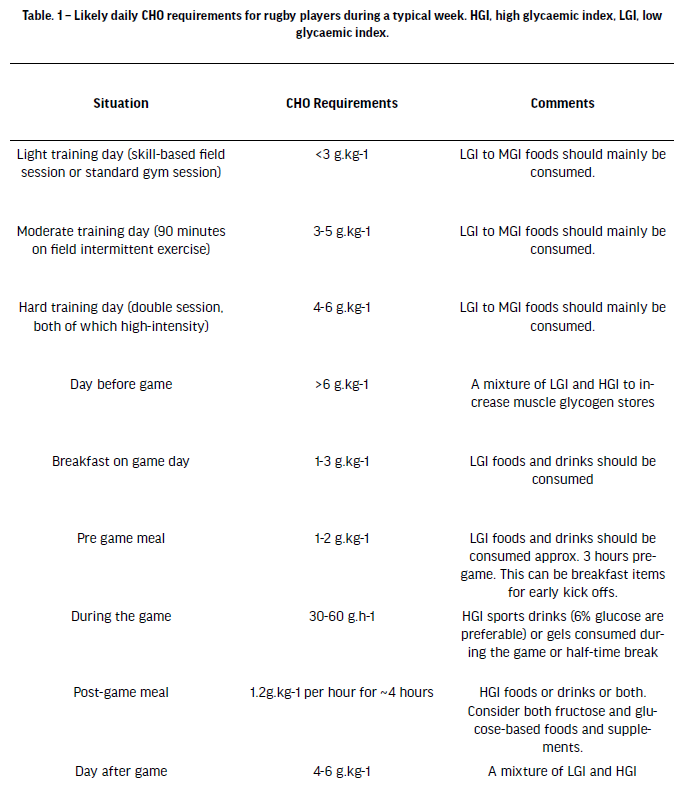
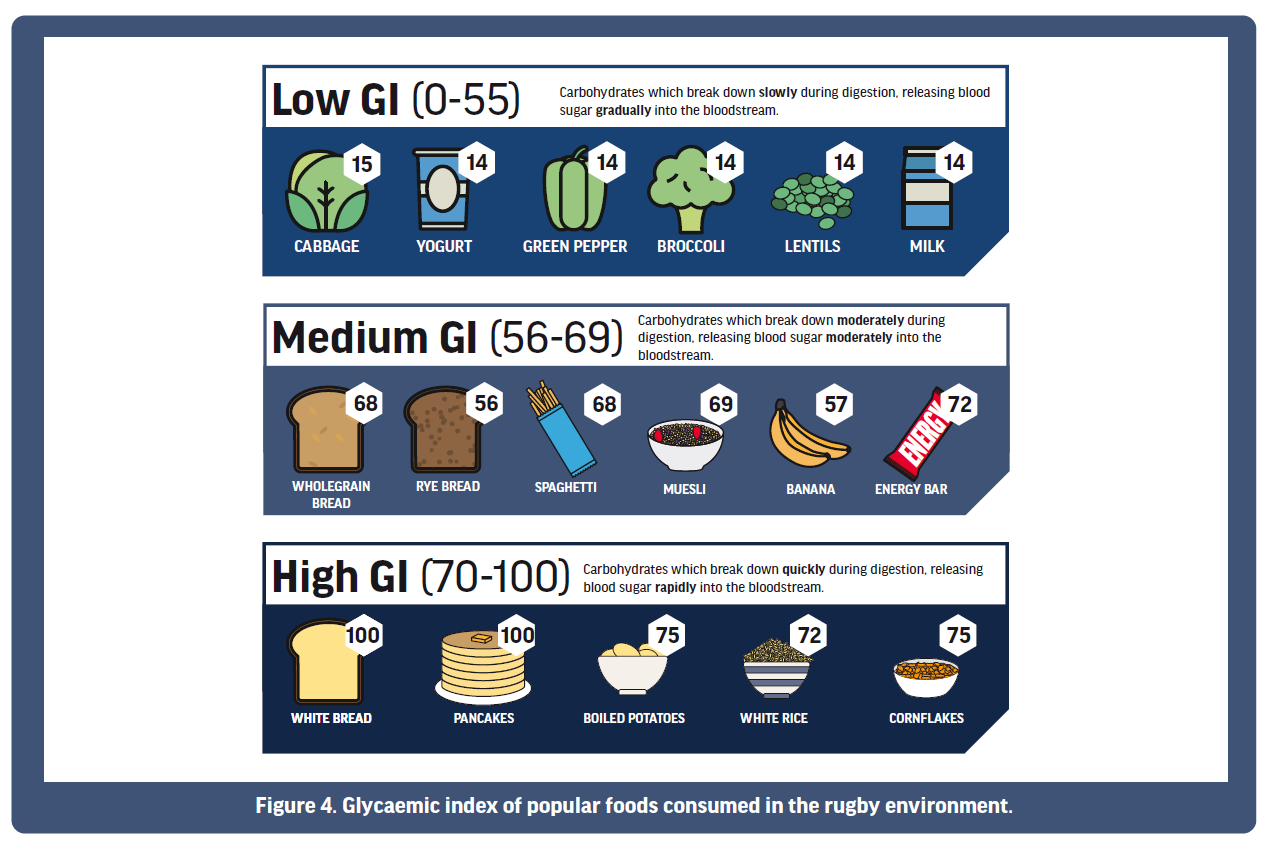
Carbohydrate loading for game-play
As rugby is a high-intensity intermittent sport, the primary fuel for game day performance is CHO, and so it is important to commence competition with high muscle glycogen stores. Whilst a traditional CHO load could take 48-72 hours, more recent research has observed that sufficient CHO can be loaded in the muscle (as glycogen) with 1 day of a CHO rich diet when combined with reduced activity (22). This means that in the 24-36 hours preceding competition a significant increase in CHO intake to approximately 6 g.kg-1 body mass should be employed. In practical terms, for a 100 kg rugby player this would equate to 600g of CHO, which in food terms is 12 large jacket potatoes. Practical experience demonstrates that many athletes often do not fully appreciate the importance of adequately ‘fuelling up’ with CHO in the days prior to competition and are more concerned with the pre-competition meal per se. One reason is that players share concerns about feeling too full or not wanting to gain fat mass from overconsuming CHO. We have previously shown the risk of premature fatigue and glycogen depletion from players under-fuelling with CHO and so going into a match having consumed 3g.kg-1 rather than 6g.kg-1 in the 36 hours prior to the game (18). In practical terms, this usually involves increasing the CHO intake throughout a day by the addition of fruit smoothies and CHO supplementation, as well as having a dessert after dinner, something often appreciated by the players! Figure 6 depicts an example GD-1 carbohydrate intake.
The pre-game meal
The pre-game meal is normally the last main meal rugby players will consume prior to the start of the game. This meal provides an opportunity for further CHO to be consumed from both foods and liquids and can provide a small top up to the muscle but especially the liver stores of glycogen which is usually reduced after an overnight fast (23,24). Regardless of the timing of game-play, it is advised that the pre-game meal be consumed 3-4 hours prior to kick off, to allow sufficient time for digestion and avoid gastrointestinal problems such as nausea and feelings of gut fullness. For example, for a 15:00 kick off, the pre-game meal should be consumed between 11:00-12:00. For an 20:00 kick off, the pre-game meal should be consumed between 16:00-17:00. Figure 7 depicts an example MD carbohydrate plan.
Many rugby players may be concerned about feeling too full before the start of a game, or experience nerves which can reduce their desire for a pre-game meal. Whilst it is important that the stomach is reasonably empty at the time of commencing exercise, ensuring that the digestion and absorption of the pre-game meal does not compete with the exercising muscles for blood supply, it is also a useful meal for final top ups to CHO stores. Consumption of high fibre (e.g., fibrous vegetables) and high fat foods (even those associated with protein sources such as red meat and cheese) should be avoided since they slow down the rate of gastric emptying. The pre-game meal should be lower in energy intake but sufficient to provide adequate fuelling.
Carbohydrate during exercise
Following the 24-36 hour CHO loading strategy as well as that of the pre-game meal, the next step is to ensure adequate fuel availability during the game. It is well documented that consuming additional CHO during exercise can improve exercise performance (23) especially when the exercise is prolonged, such as an 80-minute rugby game. The mechanisms underpinning enhanced performance with exogenous CHO provision may be due to a combination of factors including: the prevention of hypoglycaemia, the maintenance of high CHO oxidation rates, muscle glycogen sparing and effects on the central nervous system (for a review see (25). Regardless of the mechanisms behind the benefits of exogenous CHO provision during games, rugby players are advised to consume 30-60g of CHO per hour and given there are no difference in exogenous CHO oxidation rates between liquid or sports gels (26), it is prudent to provide access to both of these CHO sources during exercise. Many players enjoy a combination of both liquids and gels and so practitioners should encourage players to practice strategies during training to identify their preferred intake to ensure 30-60 g of CHOs is being consumed during match-play.
An example in-game fuelling strategy could be:
- Post-warm up = CHO gel
- During the first half = consume water or water with a CHO-electrolyte drink
- Half-time = CHO gel and/or some fruit or a smoothie or confectionary
- During the second half = consume a CHO- electrolyte drink
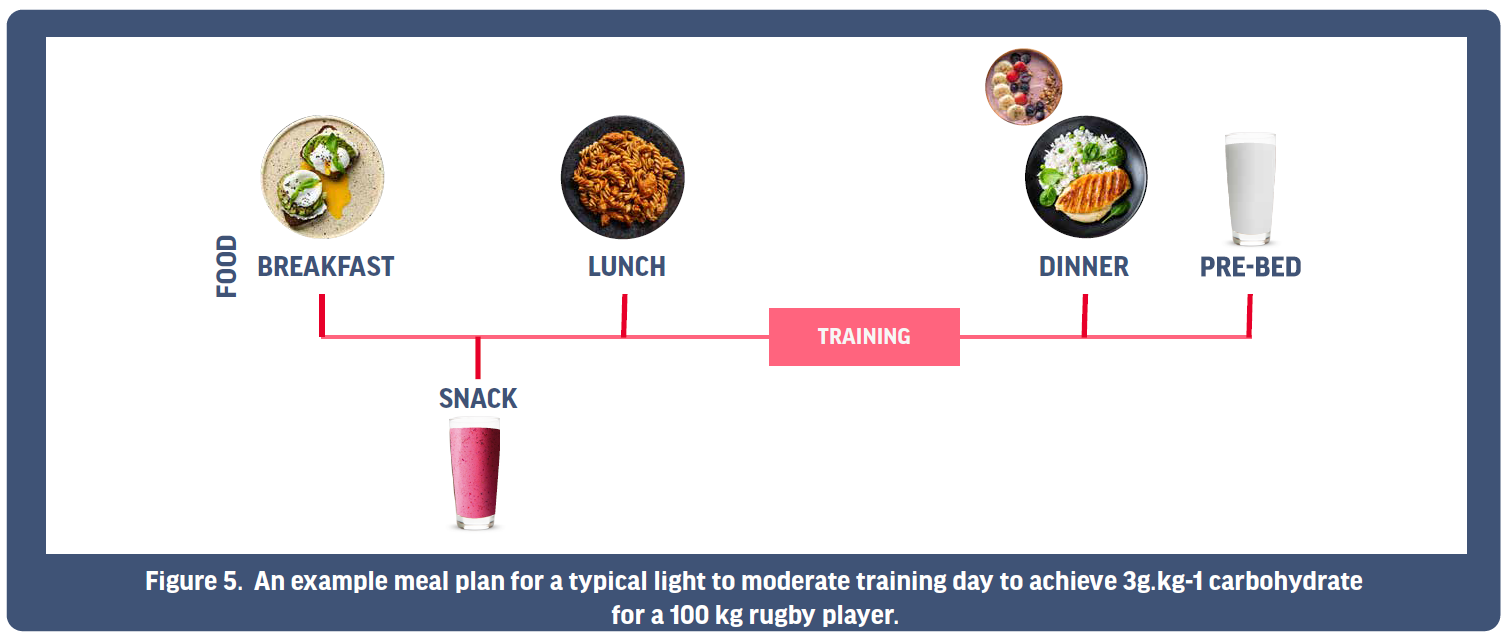
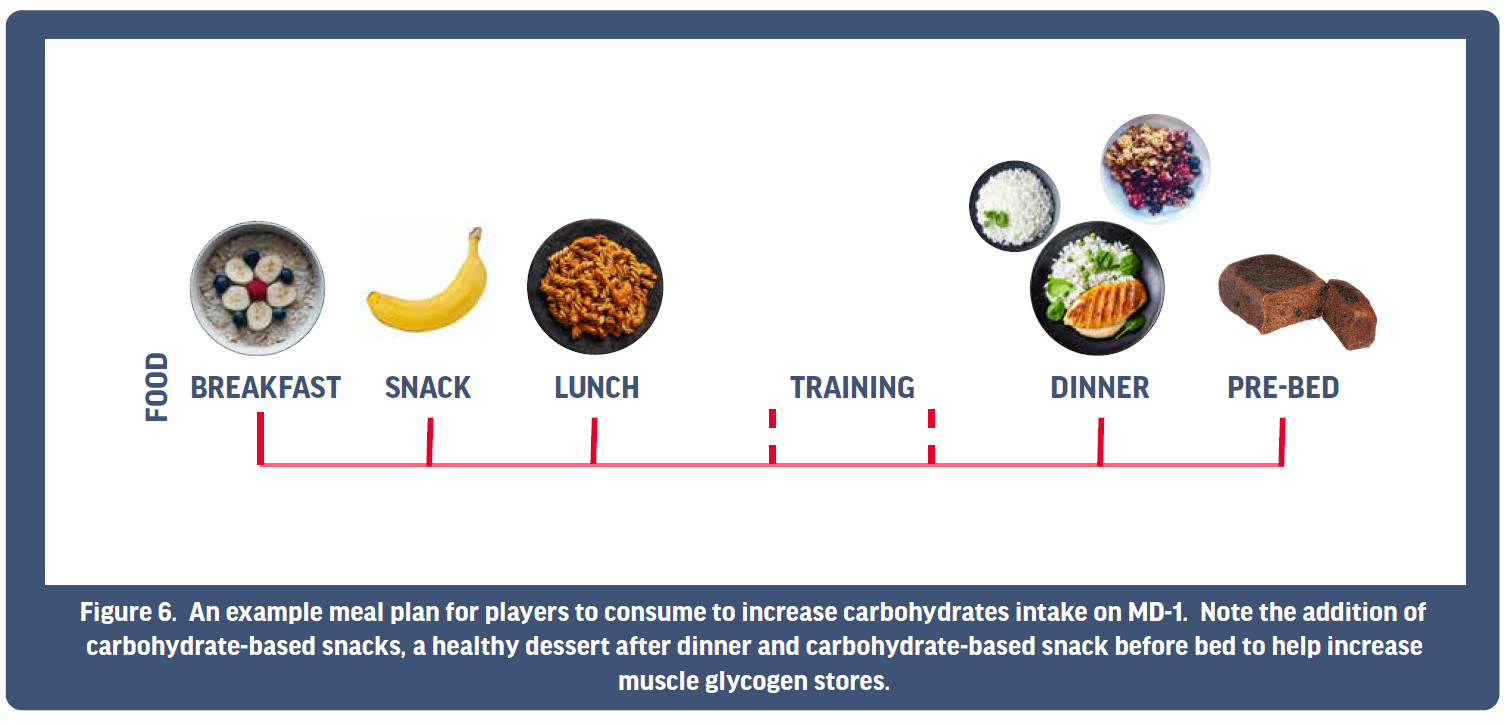
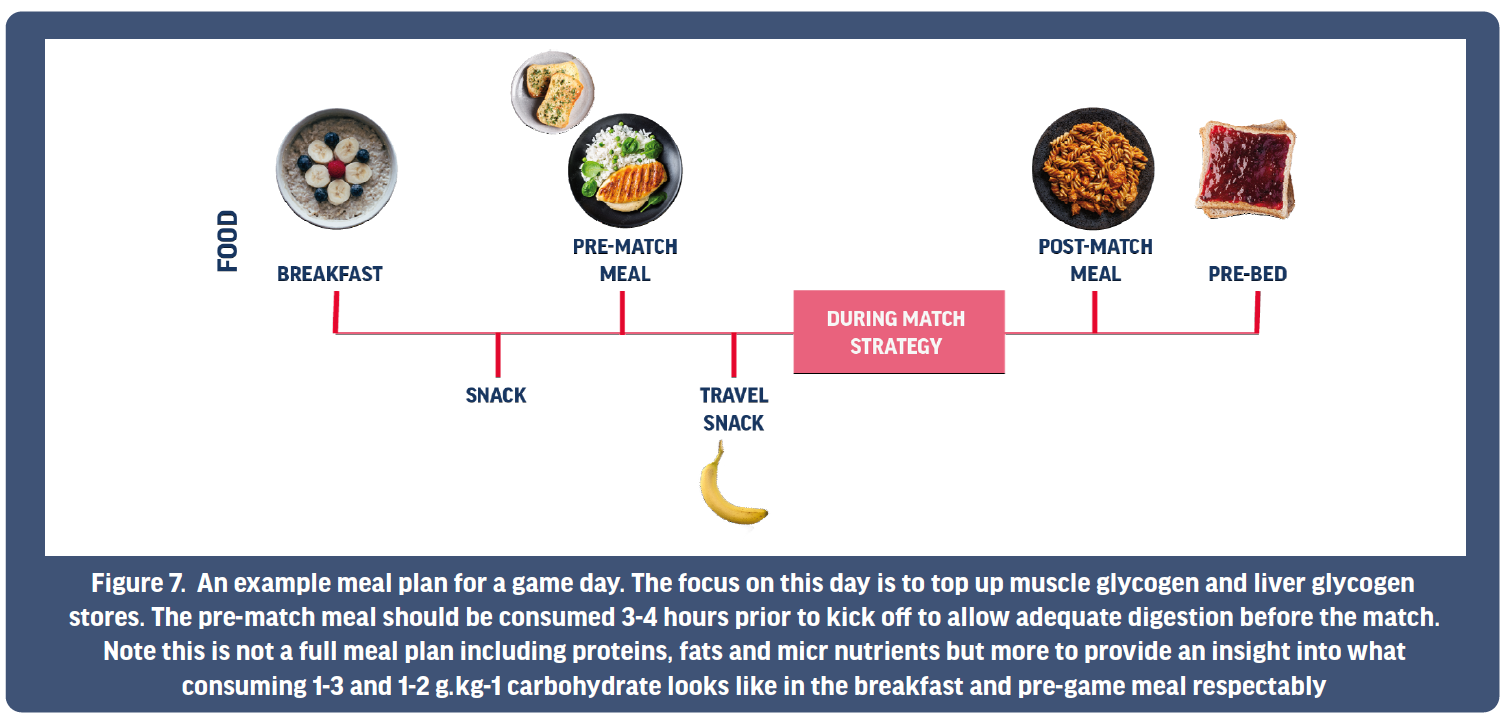
Carbohydrate intake post-match
Following rugby game play, the key nutritional priority should be the replacement of muscle glycogen stores. It is well known that the ability to replenish muscle glycogen is enhanced in the first hour following strenuous physical activity such as rugby game play. Indeed, we have shown that if CHO is not optimally ingested in the first hour post-exercise, muscle glycogen is not fully restored 48 hours later despite a high CHO diet (27). The suggested CHO intake is to have approximately 1g.kg-1 per hour for 3 hours post exercise, i.e. for a 90 kg player they would need 90g immediately post game, then a further 90g at 1 hour and 2 hours post game. Recent data from our research team performed on professional rugby players in the English Premiership has also suggested that the physical collisions associated with rugby match play increase the requirement for CHO in the hours and days after a match (28). Interestingly, metabolic rate and CHO oxidation are elevated the day after a match, thereby suggesting that an increase in CHO intake is desired. The forwards in particular, showed a greater magnitude of change compared with the backs, which likely relates with the forwards involved in a higher number of intense collisions. Clearly there is a need to fuel the recovery window appropriately and this requires sufficient CHO as well as protein.
It is also important to remember that the CHO consumed in the first few hours after a game should be high GI with research demonstrating that such foods consumed over a 24 hour period post-exercise results in greater muscle glycogen re-synthesis compared with low GI foods (29). Practically this can work well as this can include foods that players have been restricting over the week and, as such, can be viewed as somewhat of a treat meal. Whether or not the CHO is provided in solid or liquid form is immaterial and should be left to the athlete's preference. In practice, a selection of high GI CHO snacks and drinks should be available in the changing room and/or on the journey home. A smoothie is an easy way to support post-game recovery and an example recipe is provided to the left in Figure 8.
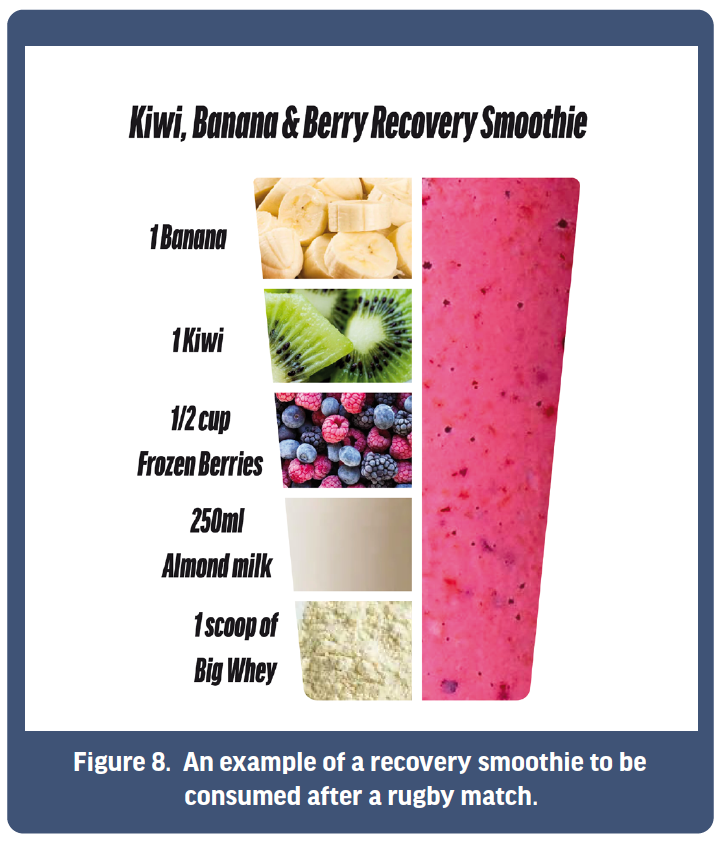
Protein requirements for rugby players
Proteins are essential for life and are crucial for a variety of key functions in the human body. The body contains structural proteins, contractile proteins, immunoproteins and regulatory proteins. This extremely diverse range of functions is achieved due to the extreme variation in the structure of each protein. Proteins are made from amino acids that form together in a specific order to create proteins. Of the 20 amino acids used to make proteins, 9 are classed as essential and the rest non-essential. Essential amino acids must be consumed in the diet, whereas the body can make its own non-essential amino acids. It is crucial to recognise that proteins are continually broken down and re-synthesised throughout the day. This constant turnover allows for damaged proteins to be removed and replaced, and new proteins to be formed in response to exercise training. Despite protein supplements being the most widely used of all sports supplements, the protein requirement of rugby players remains unclear. When it comes to a rugby player's requirement for protein, it is often useful to consider it in line with the 3 T's of sport nutrition, these being Total, Type and Timing. Whilst there appears to be a lot of focus on Total, we would argue that Timing and Type are equally important when it comes to the protein requirements for elite rugby players.
Total protein
It is generally accepted that rugby players are different to the sedentary individual. Therefore, one would assume that the protein requirements recommended for sedentary individuals (0.8 g.kg-1) (30) should be different to that of a professional rugby player. Recent research we have performed with rugby players shows professional players consuming ~2.5 g.kg-1 of protein which for a 100 kg rugby player means a total intake of 250 g of protein (8-10 chicken breasts or 8-10 standard servings of whey protein powder!). Consuming this amount of protein can sometimes be difficult and so many players consume a combination of both food and supplements. Indeed, professional players consume approximately 0.5-1.2 g.kg-1 via supplements (31). It should be acknowledged that the evidence for such high amounts of protein is somewhat limited with 1.8g g.kg-1 body mass per day often being cited as an appropriate upper amount (30) unless the athlete is on a hypocaloric diet to drop body fat, or injured where amounts in the region of 2.5 g.kg-1 body mass per day have been recommended to maintain current muscle mass and minimise muscle atrophy (32).
Practically however, instead of rugby players focussing on the total amount of protein consumed in a given day, it is may be more appropriate to focus upon consuming a regular supply of protein throughout the day, i.e. ensuring each meal and snack has a good amount of protein within it. The most recent suggestions point towards around 0.4 g.kg-1 body mass per meal being an ideal amount to consume per meal. For a 100kg rugby player this equates to 40g protein which is a large chicken breast, tin of tuna or 6 eggs (see Table 2 for sources of protein in commonly consumed foods).
Timing of protein
Exercise performed in the fasted state has the potential to result in a net loss of muscle protein (33)(33) something which is usually undesirable for rugby players. In practice such fasted exercise is not uncommon, especially with younger players who may not make time to consume food prior to exercise, or even with older players who have other commitments. It is therefore crucial that players find the time to consume some high quality protein containing foods before (34) or immediately post-exercise (35). Whilst the research suggesting pre-exercise protein is best is somewhat equivocal, there is an overwhelming consensus that protein consumed after exercise is ideal for promoting muscle protein synthesis (35). Practically however, the consumption 0.4 g.kg-1 body mass (about 40g) of high-quality protein taken prior to exercise and then again immediately following exercise may be the best way to ensure maximum rates of muscle protein synthesis.
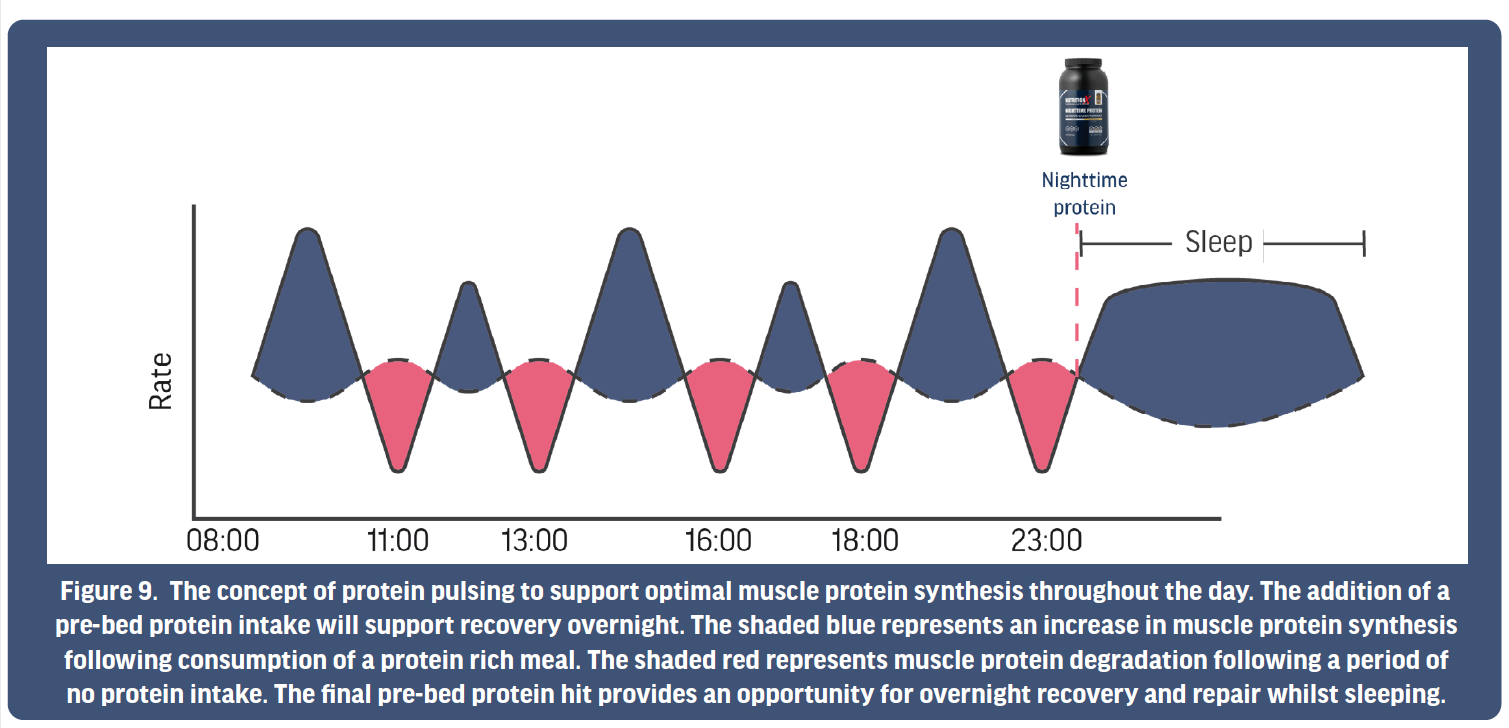
Given that rugby players aim to achieve somewhere in the region of 2 g.kg-1 body mass per day, and considering 0.4 g.kg-1 body mass appears to be an ideal amount per meal, it is clear that a rugby player will require more than 3 standard meals per day (Breakfast, Lunch and Dinner). To achieve the total amount required, five protein feeding opportunities may be required throughout the day, including a feeding before bed (Figure 9). This is especially important given studies have shown that muscle protein synthesis is maximised when protein is consumed regularly throughout the day rather than more sporadic bolus doses, even when the same total amount of protein is consumed (36).
Type of protein
The 3 major protein supplements for athletes are whey and casein from bovine milk, and soy. Whey protein results in greater muscle protein synthesis post-exercise compared with both casein or soy-based protein (37). This is likely to result from the speed in which whey increases blood amino acid concentrations compared with casein and soy. It was interesting to note in this study that the soy protein resulted in a more rapid increase in total amino acids in the blood but a slower increase in leucine concentration, suggesting that leucine availability is crucial in stimulating muscle protein synthesis. It appears that leucine plays a key role in switching on muscle protein synthesis, acting as a metabolic regulator (35), although it is important to stress that all of the essential amino acids are required for maximal muscle protein synthesis, whereby leucine ‘drives’ stimulation but the other amino acids provide the ‘building blocks’. An example of protein containing food is provided below (Table 2).
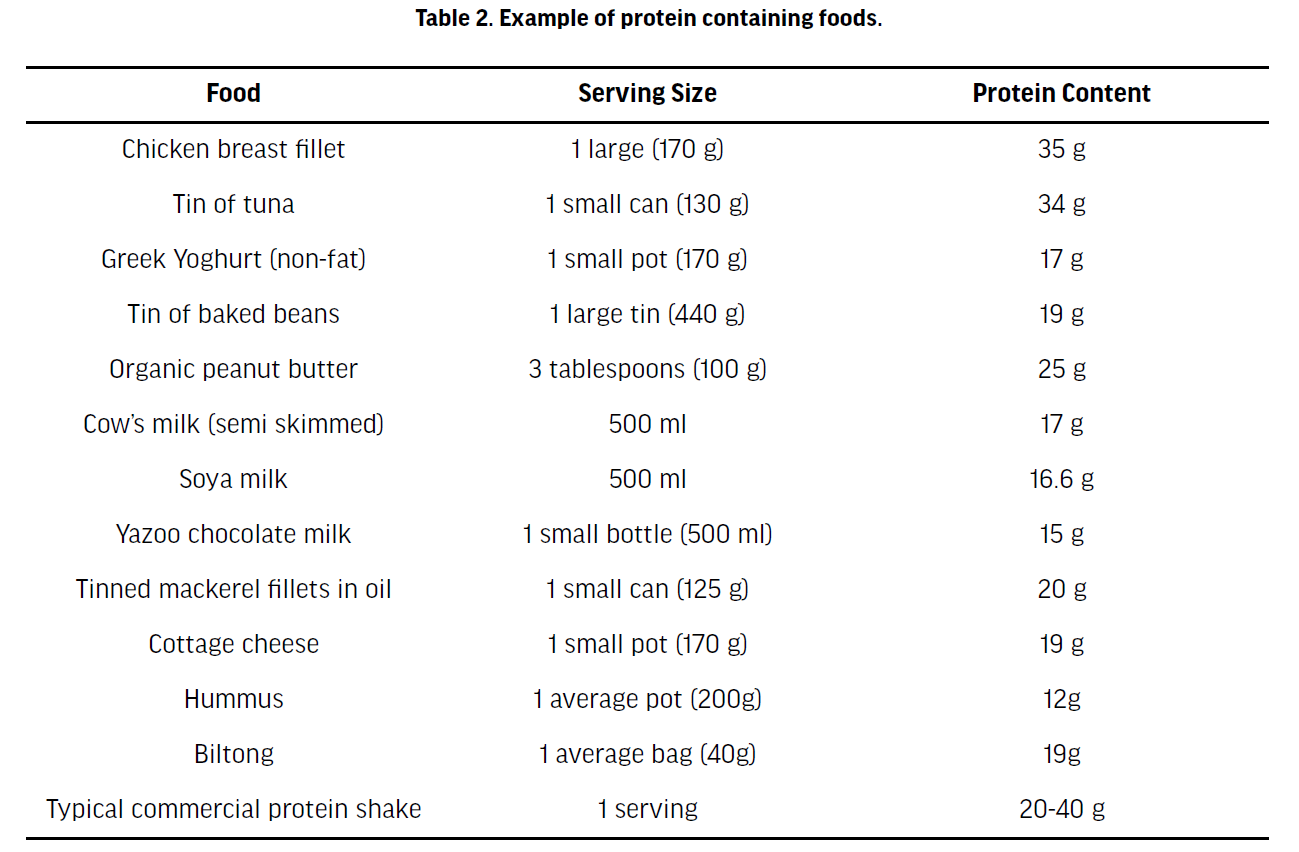
Casein is a slowly digested protein and so takes a longer time for blood concentrations of amino acids to become elevated. Since casein results in a slower appearance of amino acids in the circulation, there are suggestions that when consumed 30-60 mins before bed it may provide a sustained delivery of amino acids during the overnight fast and thus maintain protein synthesis during this time (38). In practice, rugby players may consume a whey shake made with milk which is rich in casein, or a specialised casein-based supplement.
Plant-based protein
As highlighted in the September 2021 edition of the Nutrition X-Change by Nanci Guest, plant-based foods are increasing in popularity in both the general public and, possibly, with professional rugby players. Plant-based food sources high in protein include soy products (tofu, tempeh, edamame, soymilk), pulses (beans, lentils, peas) and an array of plant-based meat substitutes and protein powders. Seeds, nuts, and whole grains, such as quinoa, and plant-based milks also contribute protein to the diet (Table 3). With careful planning it is possible for a rugby player to achieve their protein needs via a plant-based diet.
For further information on plant-based diets it is worth consulting the September 2021 edition of the Nutrition X-Change by Nanci Guest titled “Plant-based and vegan diets in exercise and sport”.
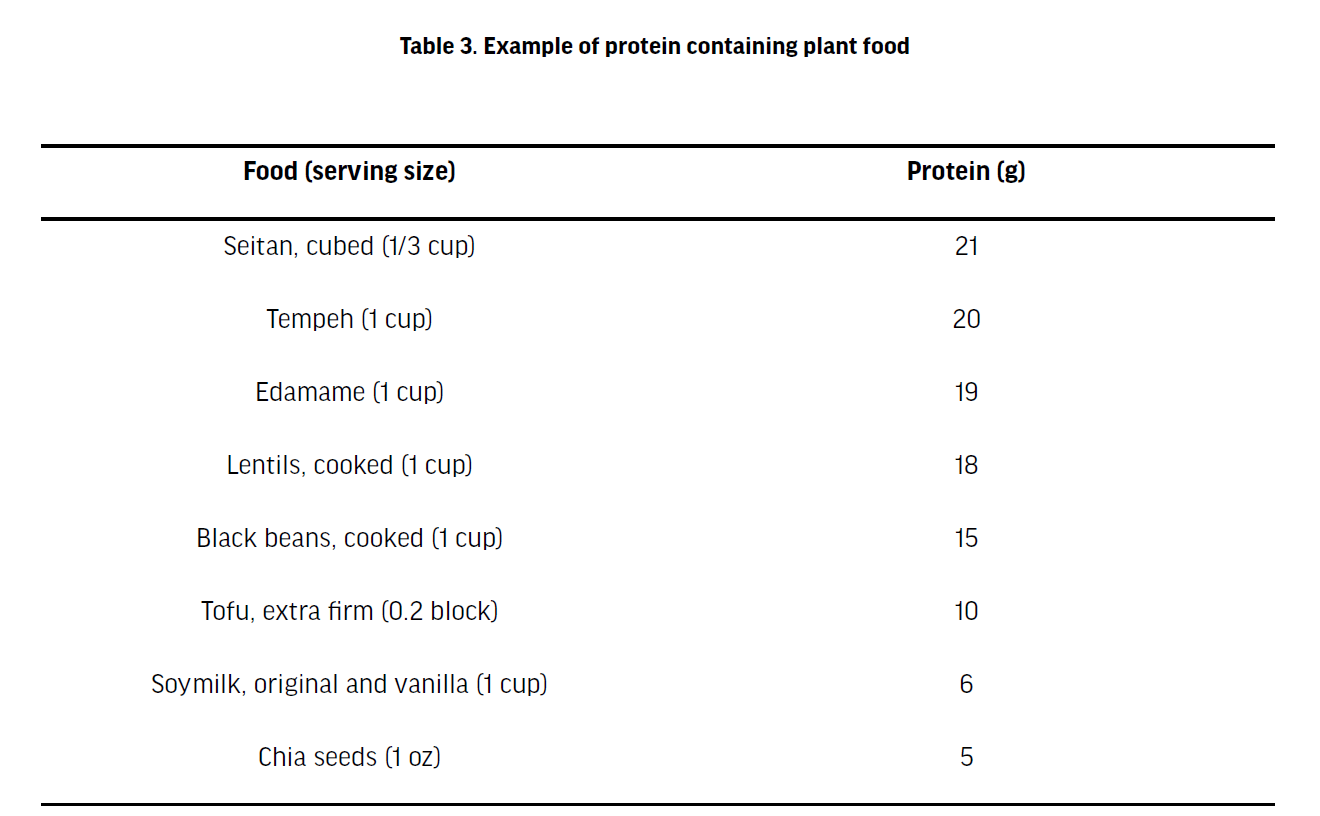
Hydration requirements
During rugby training and games, core (and muscle) temperatures can increase to >39ºC, and the main mechanism for losing heat during is through evaporation of sweat. As a result, some degree of exercise-induced dehydration happens, which may lead to a decrement in performance. Potential mechanisms underpinning dehydration-induced decrements in physical and mental performance include increased core temperature and cardiovascular strain, greater muscle glycogen utilisation and impaired brain function. In addition to fluid loss, sweat also contains electrolytes such as sodium, chloride, potassium, calcium and magnesium. Loss of sodium is the most significant for rugby players and salt losses between 2-13 g have been observed during training and competition. The importance of high salt losses are underscored by observations linking them to exercise-related muscle cramps (38) and for this reason, it is important to identify rugby players who are salty sweaters so as to develop individually tailored hydration strategies. Simple monitoring strategies such as examining clothing post-exercise for salt stains may help identify such players, though sweat patch testing is the preferred objective method.
Urine testing is advantageous in assessing hydration status, and may be achieved using urine osmolality or by assessing urine colour via a urine colour chart. To ensure pre-exercise euhydration, it is recommended that 5-7 ml.kg-1 of fluid is consumed at least 4 hours prior to exercise (39). This means that a 90 kg rugby player would consume 450-630 ml of fluid. If the player does not produce urine or the urine remains dark coloured, a further 3-5 ml.kg-1 (i.e., 150-450 ml for the 90 kg rugby player) should be consumed about 2 hours before exercise. Drinking within this time schedule should allow for fluid absorption and enable urine output to return to normal levels (39). Consumption of sports drinks at this time, as opposed to water, may prove beneficial given that they not only contain electrolytes but also additional CHO. The fluid requirements of rugby players can be divided into pre, during and post exercise requirements. In order to offset the negative effects of dehydration on performance, the American College of Sports Medicine advise fluid ingestion at a rate that limits body mass loss to <2%of pre-exercise values (39) . Any attempt to drink too much fluid and thereby gain mass during exercise will lead to water intoxication and likely death (40).
Cold beverages (10ºC) are beneficial to reduce the rise in body temperature during exercise (41). On training days (as opposed to competition), players may wish to consume water or low-calorie sports drinks only, given that CHO ingestion during exercise may attenuate skeletal muscle adaptations to training as well as reduce lipid oxidation (42). After training or competition, the goal is to replace any fluid and electrolyte loss incurred by the exercise sessions. The extent (or aggressiveness) of the drinking strategy is dependent on the time-scale with which re-hydration must occur. Current guidelines recommend 1.5 kg of fluid for every 1 kg body mass loss induced by exercise (39). For example, if 2 kg of fluid is lost during a match, then 3 litres of fluid should be consumed. Furthermore, fluids should be consumed (with electrolytes) over time rather than as large boluses (43), so as to maximise fluid retention. Any players identified as salty sweaters may benefit from the addition of extra sodium to promote fluid retention and stimulate thirst (44).
Supplements for the rugby player
There is a common misconception with rugby players that supplements are essential for a successful nutritional plan and as such there are high levels of consumption in rugby playing athletes (59). However, supplements should not be a substitute for an inadequate diet. Having said that, professional, as well as busy, players may at times wish to supplement their diet with protein or CHO and so on. Additionally, there are a range of dietary supplements which are purported to help enhance training and performance. It is beyond the scope of this article to address, in detail, all the likely beneficial supplements for rugby players, and so it is noteworthy to explore some of these supplements either via the Xchange articles (such as caffeine, creatine, β-alanine, vitamin D, or omega-3 fatty acids) or refer to the A-Z of sports supplements in the British Journal of Sports Medicine.
Final thoughts and summary
Targeted individualised nutrition strategies are crucial for rugby players to ensure that they have the required physique for the game, are fully fuelled for training and competition and maximise their recovery. Players and support staff should be aware of the different demands of each playing position and thus the different body composition profiles aligned to each role on a rugby field. Whilst most players strive to achieve increased lean muscle mass with low body fat, data on professional players would suggest that a single rugby body composition profile does not exist and rather players should work with their coaches and nutritionists to maximise their own physical potential. To fuel training and competition, carbohydrate intake needs to be aligned to the demands of each training day. This allows the players to not over-consume total caloric intake when training demands are low, yet fully maximise muscle glycogen at key times of the week (i.e., GD-1 and GD). Most rugby players appreciate the importance of dietary protein and in our experience it is unusual for players to under- consume total protein on a daily basis. Perhaps a bigger issue when it comes to protein is the daily distribution and it is crucial that players are aware of the need to evenly distribute their protein over the day rather than the typical pattern of back-loading the day with increasing amounts of protein per meal as the day progresses. Education with regards to ‘book ending’ the day with protein can be useful, i.e. emphasising the need for a good source of protein upon awaking and pre bed. Finally, whilst there are many dietary supplements which can be helpful for the rugby player, it should be stressed that these should not replace a good quality diet with a food first approach advocated at all times.
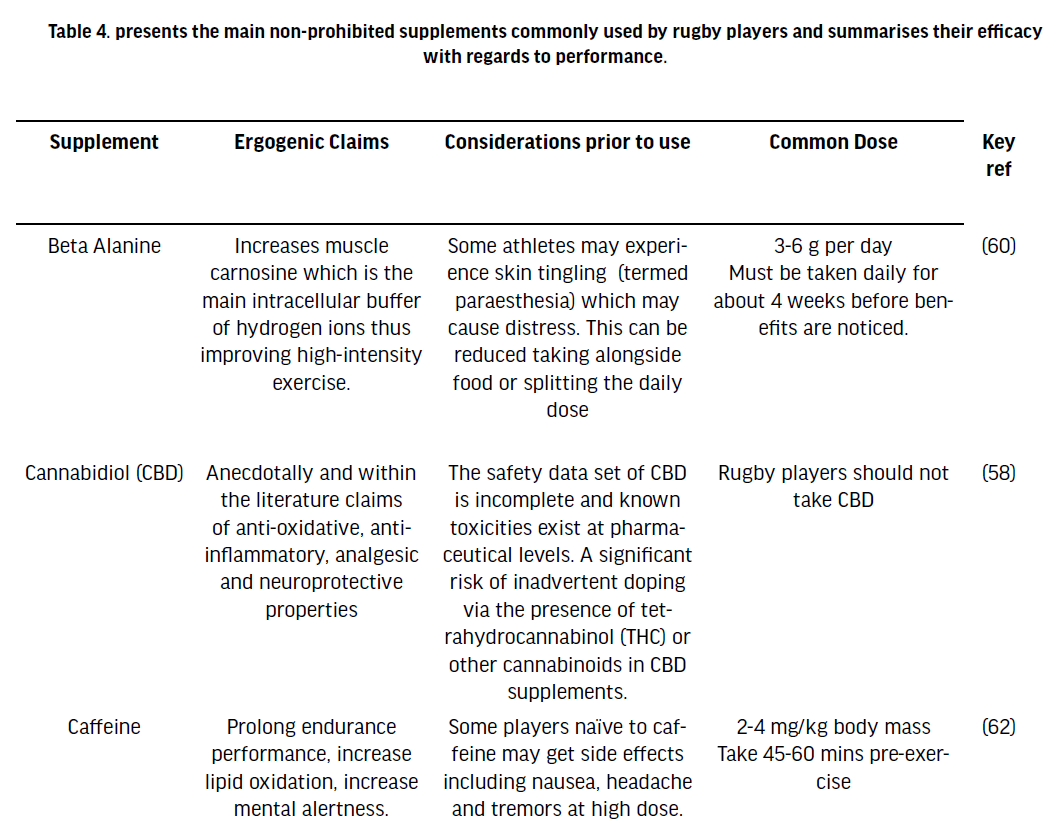
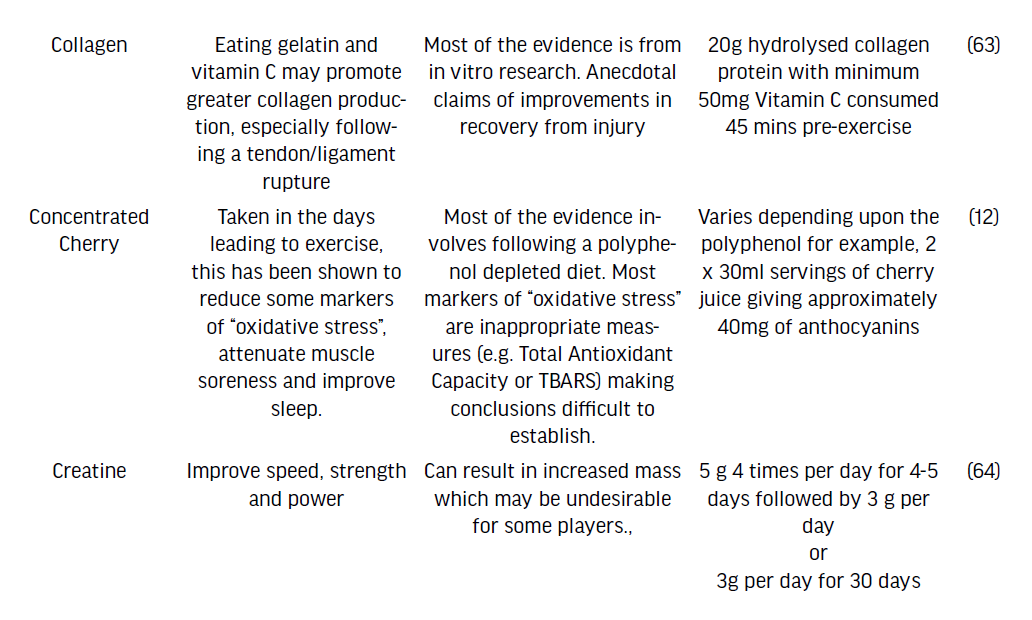
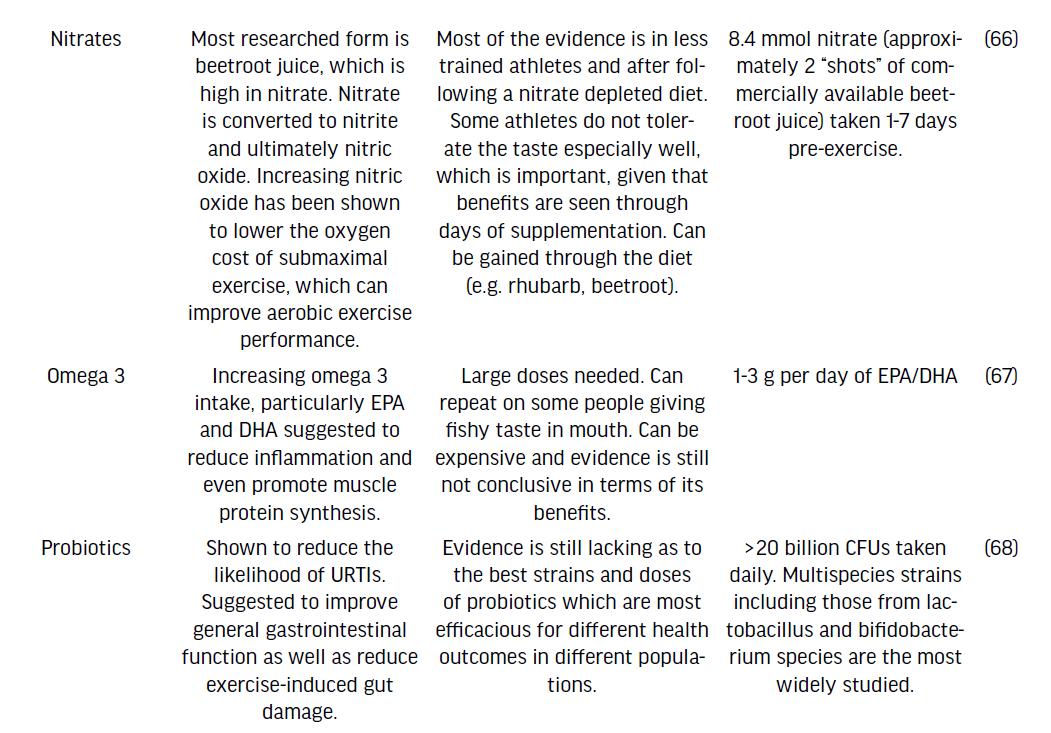
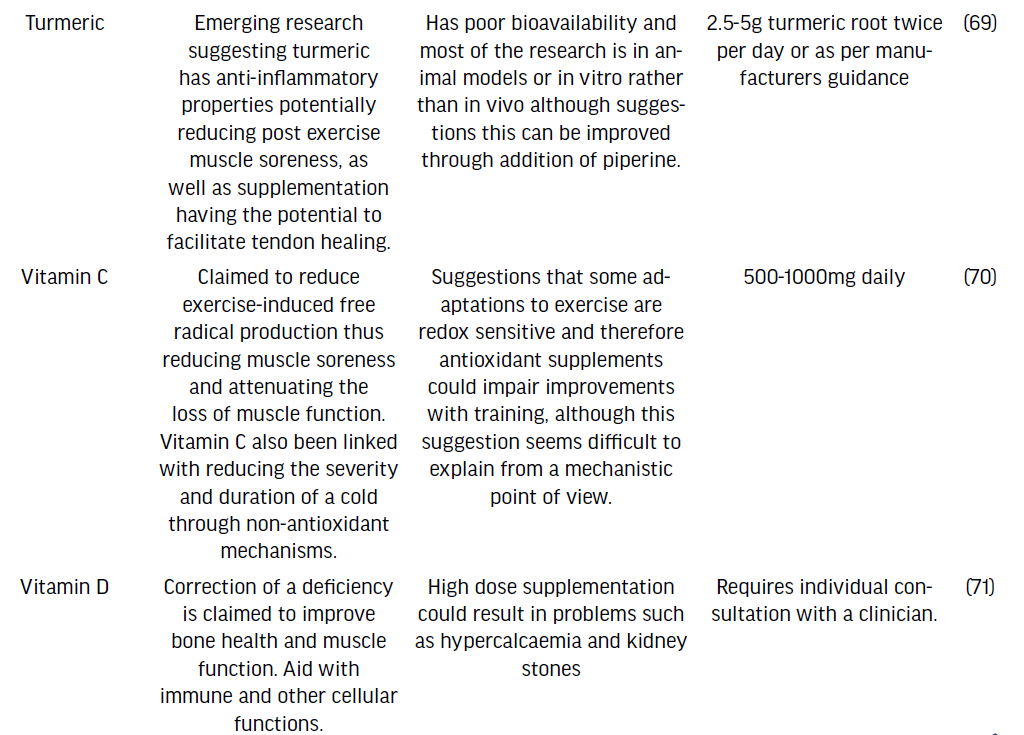
References
- Cahill N, Lamb K, Worsfold P, Headey R, Murray S. The movement characteristics of English Premiership rugby union players. J Sports Sci [Internet]. 2013 [cited 2022 Feb 6];31(3):229–37. Available from: https://pubmed.ncbi.nlm.nih.gov/23009129/
- Waldron M, Twist C, Highton J, Worsfold P, Daniels M. Movement and physiological match demands of elite rugby league using portable global positioning systems. J Sport Sci [Internet]. 2011;29(11):1223–30. Available from: http://www.ncbi. nlm.nih.gov/pubmed/21774752
- Varley MC, Gabbett T, Aughey RJ. Activity profiles of professional soccer, rugby league and Australian football match play. J Sport Sci [Internet]. 2014;32(20):1858–66. Available from: http://www. ncbi.nlm.nih.gov/pubmed/24016304
- Glassbrook DJ, Doyle TLA, Alderson JA, Fuller JT. The Demands of Professional Rugby League Match-Play: a Meta-analysis. Sport Med - Open [Internet]. 2019 Dec 1 [cited 2022 Jan 31];5(1). Available from: /pmc/articles/PMC6560119/
- Deutsch MU, Kearney GA, Rehrer NJ. Time -motion analysis of professional rugby union players during match-play. J Sports Sci [Internet]. 2007 Feb 15 [cited 2022 Jan 31];25(4):461–72. Available from: https://pubmed.ncbi.nlm.nih.gov/17365533/
- Cunniffe B, Proctor W, Baker JS, Davies B. An evaluation of the physiological demands of elite rugby union using Global Positioning System tracking software. J strength Cond Res [Internet]. 2009 Jul [cited 2021 Dec 5];23(4):1195–203. Available from: https://pubmed.ncbi.nlm.nih.gov/19528840/
- Coughlan GF, Green BS, Pook PT, Toolan E, O’Connor SP. Physical game demands in elite rugby union: a global positioning system analysis and possible implications for rehabilitation. J Orthop Sports Phys Ther [Internet]. 2011 [cited 2022 Jan 31];41(8):600–5. Available from: https://pubmed.ncbi. nlm.nih.gov/21654094/
- Bevan HR, Bunce PJ, Owen NJ, Bennett MA, Cook CJ, Cunningham DJ, et al. Optimal loading for the development of peak power output in professional rugby players. J Strength Cond Res. 2010;
- Bradley WJ, Cavanagh BP, Douglas W, Donovan TF, Morton JP, Close GL. Quantification of training load, energy intake, and physiological adaptations during a rugby preseason: a case study from an elite European rugby union squad. J Strength Cond Res [Internet]. 2015;29(2):534–44. Available from: http://www.ncbi.nlm.nih.gov/pubmed/25029003
- Gabbett TJ, Jenkins DG, Abernethy B. Relative importance of physiological, anthropometric, and skill qualities to team selection in professional rugby league. J Sports Sci [Internet]. 2011 [cited 2022 Jan 31];29(13):1453–61. Available from: https://pubmed. ncbi.nlm.nih.gov/21834623/
- Hudson JF, Phelan MM, Owens DJ, Morton JP, Close GL, Stewart CE. ‘Fuel for the Damage Induced’: Untargeted Metabolomics in Elite Rugby Union Match Play. Metabolites [Internet]. 2021 [cited 2021 Dec 5];11(8). Available from: https://pubmed.ncbi.nlm. nih.gov/34436485/
- Morehen JC, Clarke J, Batsford J, Barrow S, Brown AD, Stewart CE, et al. Montmorency tart cherry juice does not reduce markers of muscle soreness, function and inflammation following professional male Rugby League match-play. Eur J Sport Sci. 2020;
- Lees MJ, Oldroyd B, Jones B, Brightmore A, O’Hara JP, Barlow MJ, et al. Three-Compartment Body Composition Changes in Professional Rugby Union Players Over One Competitive Season: A Team and Individualized Approach. J Clin Densitom [Internet]. 2017 Jan 1 [cited 2021 Dec 5];20(1):50–7. Available from: https://pubmed.ncbi.nlm.nih.gov/27161801/
- Morehen JC, Routledge HE, Twist C, Morton JP, Close GL. Position specific differences in the anthropometric characteristics of elite European Super League rugby players. Eur J Sport Sci [Internet]. 2015;15(6):523–9. Available from: https://www.ncbi. nlm.nih.gov/pubmed/25600232
- Morehen JC, Clarke J, Batsford J, Highton J, Erskine RM, Morton JP, et al. Development of anthropometric characteristics in professional Rugby League players: Is there too much emphasis on the pre-season period? Eur J Sport Sci [Internet]. 2019 Dec 4;1–10. Available from: https://www.tandfonline. com/doi/full/10.1080/17461391.2019.1695953
- Posthumus L, Macgregor C, Winwood P, Darry K, Driller M, Gill N. Physical and Fitness Characteristics of Elite Professional Rugby Union Players. Sport (Basel, Switzerland) [Internet]. 2020 [cited 2021 Dec 5];8(6). Available from: https://pubmed.ncbi.nlm.nih.gov/32517080/
- Krustrup P, Mohr M, Steensberg A, Bencke J, Kjaer M, Bangsbo J. Muscle and blood metabolites during a soccer game: implications for sprint performance. Med Sci Sport Exerc [Internet]. 2006;38(6):1165–74. Available from: http://www.ncbi. nlm.nih.gov/pubmed/16775559
- Bradley WJ, Morehen JC, Haigh J, Clarke J, Donovan TF, Twist C, et al. Muscle glycogen utilisation during Rugby match play: Effects of pre-game carbohydrate. J Sci Med Sport [Internet]. 2016;19(12):1033–8. Available from: https://www. ncbi.nlm.nih.gov/pubmed/27134132
- Burke LM, Hawley JA, Wong SH, Jeukendrup AE. Carbohydrates for training and competition. J Sport Sci [Internet]. 2011;29 Suppl 1:S17-27. Available from: http://www.ncbi.nlm.nih.gov/pubmed/21660838
- Morehen JC, Bradley WJ, Clarke J, Twist C, Hambly C, Speakman JR, et al. The Assessment of Total Energy Expenditure During a 14-Day In-Season Period of Professional Rugby League Players Using the Doubly Labelled Water Method. Int J Sport Nutr Exerc Metab [Internet]. 2016;26(5):464–72. Available from: https://www.ncbi.nlm.nih.gov/pubmed/27096279
- Stevenson E, Williams C, Biscoe H. The metabolic responses to high carbohydrate meals with different glycemic indices consumed during recovery from prolonged strenuous exercise. Int J Sport Nutr Exerc Metab [Internet]. 2005 [cited 2021 Dec 5];15(3):291–307. Available from: https://pubmed. ncbi.nlm.nih.gov/16131699/
- Bussau VA, Fairchild TJ, Rao A, Steele P, Fournier PA. Carbohydrate loading in human muscle: an improved 1 day protocol. Eur J Appl Physiol [Internet]. 2002 Jul [cited 2021 Dec 5];87(3):290–5. Available from: https://pubmed.ncbi.nlm.nih. gov/12111292/
- Casey A, Mann R, Banister K, Fox J, Morris PG, Macdonald IA, et al. Effect of carbohydrate ingestion on glycogen resynthesis in human liver and skeletal muscle, measured by (13)C MRS. Am J Physiol Endocrinol Metab [Internet]. 2000 [cited 2021 Dec 19];278(1). Available from: https://pubmed.ncbi.nlm. nih.gov/10644538/
- Sherman WM, Peden MC, Wright DA. Carbohydrate feedings 1 h before exercise improves cycling performance. Am J Clin Nutr [Internet]. 1991 [cited 2021 Dec 19];54(5):866–70. Available from: https://pubmed.ncbi.nlm.nih.gov/1951158/
- Karelis AD, Smith JEW, Passe DH, Pronnet F. Carbohydrate administration and exercise performance: what are the potential mechanisms involved? Sports Med [Internet]. 2010 [cited 2021 Dec 19];40(9):747–63. Available from: https://pubmed. ncbi.nlm.nih.gov/20726621/
- Pfeiffer B, Stellingwerff T, Zaltas E, Jeukendrup AE. CHO oxidation from a CHO gel compared with a drink during exercise. Med Sci Sports Exerc [Internet]. 2010 Nov [cited 2021 Dec 19];42(11):2038–45. Available from: https://pubmed. ncbi.nlm.nih.gov/20404763/
- Bradley WJ, Hannon MP, Benford V, Morehen JC, Twist C, Shepherd S, et al. Metabolic demands and replenishment of muscle glycogen after a rugby league match simulation protocol. J Sci Med Sport [Internet]. 2017; Available from: https://www.ncbi. nlm.nih.gov/pubmed/28238618
- Hudson JF, Cole M, Morton JP, Stewart CE, Close GL. Daily Changes of Resting Metabolic Rate in Elite Rugby Union Players. Med Sci Sports Exerc. 2020;
- Burke LM, Collier GR, Hargreaves M. Muscle glycogen storage after prolonged exercise: effect of the glycemic index of carbohydrate feedings. J Appl Physiol [Internet]. 1993 [cited 2021 Dec 19];75(2):1019–23. Available from: https://pubmed. ncbi.nlm.nih.gov/8226443/
- Phillips SM. Protein requirements and supplementation in strength sports. Nutrition [Internet]. 2004 Jul [cited 2021 Dec 20];20(7–8):689–95. Available from: https://pubmed.ncbi.nlm.nih. gov/15212752/
- Bradley WJ, Cavanagh B, Douglas W, Donovan TF, Twist C, Morton JP, et al. Energy intake and expenditure assessed ‘in-season’ in an elite European rugby union squad. Eur J Sport Sci [Internet]. 2015;15(6):469–79. Available from: http://www.ncbi. nlm.nih.gov/pubmed/26055695
- Tipton KD. Nutritional Support for Exercise-Induced Injuries. Sports Med [Internet]. 2015 Nov 1 [cited 2021 Dec 19];45:93. Available from: /pmc/articles/PMC4672013/
- Phillips SM, Tipton KD, Ferrando AA, Wolfe RR. Resistance training reduces the acute exercise-induced increase in muscle protein turnover. Am J Physiol [Internet]. 1999 [cited 2021 Dec 19];276(1). Available from: https://pubmed.ncbi.nlm.nih. gov/9886957/
- Tipton KD, Rasmussen BB, Miller SL, Wolf SE, Owens-Stovall SK, Petrini BE, et al. Timing of amino acid-carbohydrate ingestion alters anabolic response of muscle to resistance exercise. Am J Physiol Endocrinol Metab [Internet]. 2001 [cited 2021 Dec 19];281(2). Available from: https://pubmed.ncbi. nlm.nih.gov/11440894/
- Phillips SM. The science of muscle hypertrophy: making dietary protein count. Proc Nutr Soc [Internet]. 2011 Feb [cited 2021 Dec 19];70(1):100–3. Available from: https://pubmed.ncbi. nlm.nih.gov/21092368/
- Areta JL, Burke LM, Ross ML, Camera DM, West DWD, Broad EM, et al. Timing and distribution of protein ingestion during prolonged recovery from resistance exercise alters myofibrillar protein synthesis. J Physiol. 2013/03/04. 2013 May;591(9):2319–31.
- Phillips SM, Tang JE, Moore DR. The Role of Milk- and Soy-Based Protein in Support of Muscle Protein Synthesis and Muscle Protein Accretion in Young and Elderly Persons. J Am Coll Nutr [Internet]. 2009 Aug 1 [cited 2021 Dec 20];28(4):343–54. Available from: https://pubmed.ncbi.nlm.nih.gov/20368372/
- Bergeron MF. Heat cramps: fluid and electrolyte challenges during tennis in the heat. J Sci Med Sport [Internet]. 2003 [cited 2022 Feb 3];6(1):19–27. Available from: https://pubmed.ncbi.nlm.nih. gov/12801207/
- Racinais S, Alonso JM, Coutts AJ, Flouris AD, Girard O, González-Alonso J, et al. Consensus Recommendations on Training and Competing in the Heat. Sports Med [Internet]. 2015 Jul 20 [cited 2022 Feb 3];45(7):925–38. Available from: https://pubmed. ncbi.nlm.nih.gov/26002286/
- Almond CSD, Shin AY, Fortescue EB, Mannix RC, Wypij D, Binstadt BA, et al. Hyponatremia among runners in the Boston Marathon. N Engl J Med [Internet]. 2005 Apr 14 [cited 2022 Feb 3];352(15):1550–6. Available from: https://pubmed. ncbi.nlm.nih.gov/15829535/
- Lee JKW, Shirreffs SM. The influence of drink temperature on thermoregulatory responses during prolonged exercise in a moderate environment. J Sports Sci [Internet]. 2007 Jul [cited 2022 Feb 3];25(9):975–85. Available from: https://pubmed.ncbi. nlm.nih.gov/17497398/
- Morton RW, Murphy KT, McKellar SR, Schoenfeld BJ, Henselmans M, Helms E, et al. A systematic review, meta-analysis and meta-regression of the effect of protein supplementation on resistance training-induced gains in muscle mass and strength in healthy adults. Br J Sports Med. 2018;
- Kovacs EMR, Schmahl RM, Senden JMG, Brouns F. Effect of high and low rates of fluid intake on post-exercise rehydration. Int J Sport Nutr Exerc Metab [Internet]. 2002 [cited 2022 Feb 3];12(1):14–23. Available from: https://pubmed.ncbi.nlm.nih. gov/11993619/44.
- Maughan RJ, Shirreffs SM. Development of individual hydration strategies for athletes. Int J Sport Nutr Exerc Metab [Internet]. 2008 [cited 2022 Feb 3];18(5):457–72. Available from: https://pubmed. ncbi.nlm.nih.gov/19033609/
- Owens DJ, Twist C, Cobley JN, Howatson G, Close GL. Exercise-induced muscle damage: What is it, what causes it and what are the nutritional solutions? Eur J Sport Sci [Internet]. 2018 Aug 15;1–15. Available from: https://www.tandfonline.com/doi/full /10.1080/17461391.2018.1505957
- Howatson G, van Someren K a. The prevention and treatment of exercise-induced muscle damage. Sports Med [Internet]. 2008;38(6):483–503. Available from: http://www.ncbi.nlm.nih.gov/pubmed/18489195
- Sousa M, Teixeira VH, Soares J. Dietary strategies to recover from exercise-induced muscle damage. International Journal of Food Sciences and Nutrition. 2014.
- Bryer SC, Goldfarb AH. Effect of High Dose Vitamin C Supplementation on Muscle Soreness, Damage, Function, and Oxidative Stress to Eccentric Exercise. Int J Sport Nutr Exerc Metab [Internet]. 2006 Jun;16(3):270–80. Available from: http://journals. humankinetics.com/doi/10.1123/ijsnem.16.3.270
- Connolly DAJ, Lauzon C, Agnew J, Dunn M, Reed B. The effects of vitamin C supplementation on symptoms of delayed onset muscle soreness. J Sports Med Phys Fitness [Internet]. 2006 Sep;46(3):462–7. Available from: https://insights.ovid. com/crossref?an=00005768-200505001-01641
- Bowtell JL, Sumners DP, Dyer A, Fox P, Mileva KN. Montmorency cherry juice reduces muscle damage caused by intensive strength exercise. Med Sci Sports Exerc [Internet]. 2011 Aug [cited 2018 Jan 25];43(8):1544–51. Available from: http://www.ncbi. nlm.nih.gov/pubmed/21233776
- Manach C, Scalbert A, Morand C, Rémésy C, Jiménez L. Polyphenols: Food sources and bioavailability. American Journal of Clinical Nutrition. 2004.
- Connolly DAJ, McHugh MP, Padilla-Zakour OI. Efficacy of a tart cherry juice blend in preventing the symptoms of muscle damage. Br J Sports Med. 2006;
- Howatson G, McHugh MP, Hill JA, Brouner J, Jewell AP, Van Someren KA, et al. Influence of tart cherry juice on indices of recovery following marathon running. Scand J Med Sci Sports [Internet]. 2010 Dec;20(6):843–52. Available from: http://doi. wiley.com/10.1111/j.1600-0838.2009.01005.x
- Kuehl KS, Perrier ET, Elliot DL, Chesnutt JC. Efficacy of tart cherry juice in reducing muscle pain during running: a randomized controlled trial. J Int Soc Sports Nutr [Internet]. 2010;7(1):17. Available from: http://jissn.biomedcentral.com/articles/10.1186/1550-2783-7-17
- Bell PG, McHugh MP, Stevenson E, Howatson G. The role of cherries in exercise and health. Scand J Med Sci Sports [Internet]. 2014 Jun;24(3):477–90. Available from: http://doi.wiley.com/10.1111/sms.12085
- Bell PG, Walshe IH, Davison GW, Stevenson EJ, Howatson G. Recovery facilitation with Montmorency cherries following high-intensity, metabolically challenging exercise. Appl Physiol Nutr Metab. 2015;
- Hurst RD, Wells RW, Hurst SM, McGhie TK, Cooney JM, Jensen DJ. Blueberry fruit polyphenolics suppress oxidative stressinduced skeletal muscle cell damage in vitro. Mol Nutr Food Res. 2010;
- Kasper AM, Andy Sparks S, Hooks M, Skeer M, Webb B, Nia H, et al. High prevalence ofcannabidiol use within male professional rugby union and league players: A quest for pain relief and enhanced recovery. Int J Sport Nutr Exerc Metab. 2020;
- Sánchez-Oliver AJ, Domínguez R, López-Tapia P, Tobal FM, Jodra P, Montoya JJ, et al. A Survey on Dietary Supplement Consumption in Amateur and Professional Rugby Players. Foods (Basel, Switzerland) [Internet]. 2020 [cited 2022 Feb 6];10(1). Available from: https://pubmed.ncbi.nlm.nih. gov/33375061/
- Hobson RM, Saunders B, Ball G, Harris RC, Sale C. Effects of β-alanine supplementation on exercise performance: a meta-analysis. Amino Acids [Internet]. 2012 Jul [cited 2022 Feb 6];43(1):25–37. Available from: https://pubmed.ncbi.nlm.nih. gov/22270875/
- Blomstrand E. Amino acids and central fatigue. Amino Acids [Internet]. 2001 [cited 2022 Feb 6];20(1):25–34. Available from: https://pubmed.ncbi. nlm.nih.gov/11310928/
- Salinero JJ, Lara B, Del Coso J. Effects of acute ingestion of caffeine on team sports performance: a systematic review and meta-analysis. Res Sports Med [Internet]. 2019 Apr 3 [cited 2022 Feb 6];27(2):238–56. Available from: https://pubmed.ncbi. nlm.nih.gov/30518253/
- Shaw G, Serpell B, Baar K. Rehabilitation and nutrition protocols for optimising return to play from traditional ACL reconstruction in elite rugby union players: A case study. J Sports Sci [Internet]. 2019 Aug 3 [cited 2022 Feb 6];37(15):1794–803. Available from: https://pubmed.ncbi.nlm.nih.gov/30967011/
- Tarnopolsky MA. Caffeine and creatine use in sport. Ann Nutr Metab [Internet]. 2010 Feb [cited 2022 Feb 6];57 Suppl 2(SUPPL. 2):1–8. Available from: https://pubmed.ncbi.nlm.nih.gov/21346331/
- McIntosh ND, Love TD, Haszard JJ, Osborne HR, Black KE. β-Hydroxy β-Methylbutyrate (HMB) Supplementation Effects on Body Mass and Performance in Elite Male Rugby Union Players. J strength Cond Res [Internet]. 2018 Jan 1 [cited 2022 Feb 6];32(1):19–26. Available from: https://pubmed. ncbi.nlm.nih.gov/27820726/
- Nyakayiru J, Jonvik KL, Trommelen J, Pinckaers PJM, Senden JM, van Loon LJC, et al. Beetroot Juice Supplementation Improves High-Intensity Intermittent Type Exercise Performance in Trained Soccer Players. Nutrients [Internet]. 2017 Mar 22 [cited 2022 Feb 6];9(3). Available from: https://pubmed.ncbi.nlm.nih.gov/28327503/
- Black KE, Witard OC, Baker D, Healey P, Lewis V, Tavares F, et al. Adding omega-3 fatty acids to a protein-based supplement during pre-season training results in reduced muscle soreness and the better maintenance of explosive power in professional Rugby Union players. Eur J Sport Sci [Internet]. 2018 Nov 26 [cited 2022 Feb 6];18(10):1357–67. Available from: https://pubmed.ncbi.nlm.nih.gov/29985775/
- Haywood BA, Black KE, Baker D, McGarvey J, Healey P, Brown RC. Probiotic supplementation reduces the duration and incidence of infections but not severity in elite rugby union players. J Sci Med Sport [Internet]. 2014 [cited 2022 Feb 6];17(4):356–60. Available from: https://pubmed.ncbi.nlm.nih. gov/24045086/
- Barthélémy Delecroix, Abd Elbasset Abaïdia, Cédric Leduc, Brian Dawson GD. Curcumin and Piperine Supplementation and Recovery Following Exercise Induced Muscle Damage: A Randomized Controlled Trial [Internet]. J Sports Sci Med. 2017 [cited 2022 Feb 6]. p. 147–53. Available from: https://pubmed.ncbi.nlm.nih.gov/28344463/
- Close Ashton, T., McArdle, A., & Maclaren, D. P. GL. The emerging role of free radicals in delayed onset muscle soreness and contraction-induced muscle injury. Comp Biochem Physiol A Mol Integr Physiol [Internet]. 2005;142(3):257–66. Available from: https://www.ncbi.nlm.nih.gov/pubmed/16153865
- Willis KS, Peterson NJ, Larson-Meyer DE. Should we be concerned about the vitamin D status of athletes? Int J Sport Nutr Exerc Metab [Internet]. 2008 [cited 2022 Feb 6];18(2):204–24. Available from: https://pubmed.ncbi.nlm.nih.gov/18458363/


